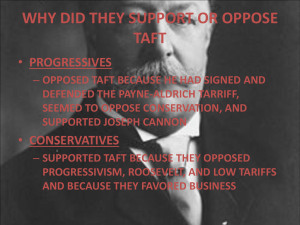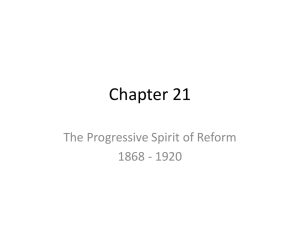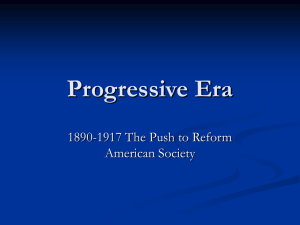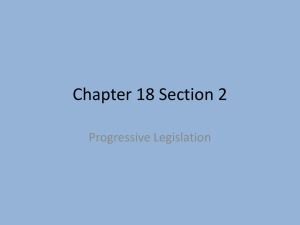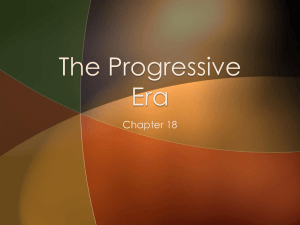Responses to Industrialization, Urbanization, and Immigration
advertisement
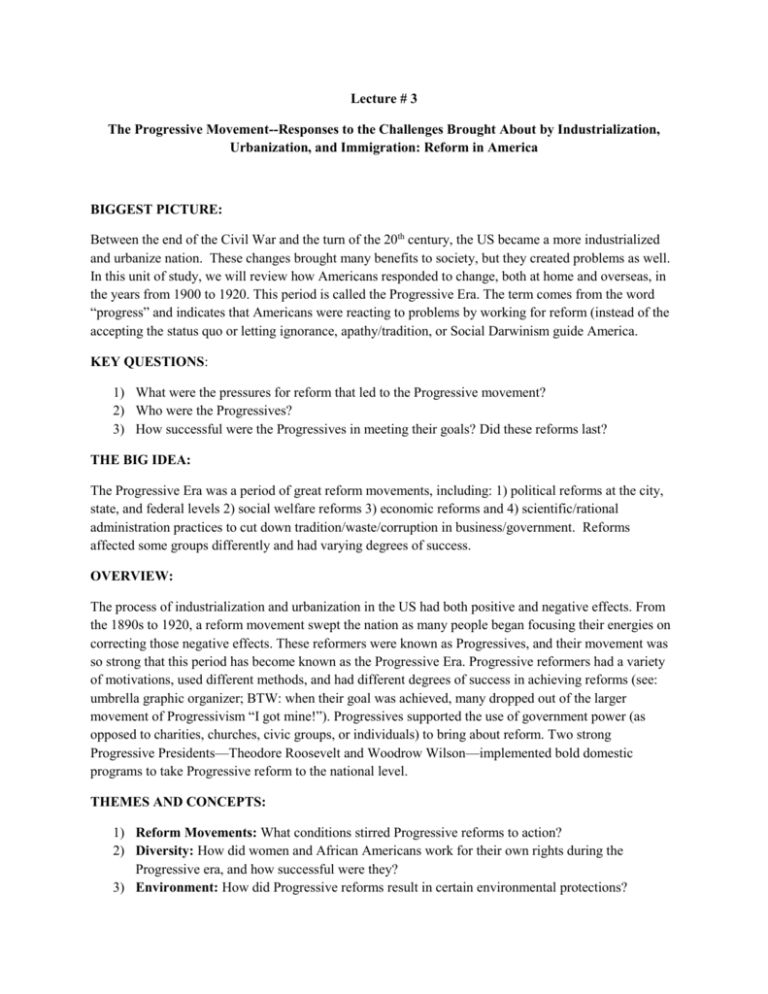
Lecture # 3 The Progressive Movement--Responses to the Challenges Brought About by Industrialization, Urbanization, and Immigration: Reform in America BIGGEST PICTURE: Between the end of the Civil War and the turn of the 20th century, the US became a more industrialized and urbanize nation. These changes brought many benefits to society, but they created problems as well. In this unit of study, we will review how Americans responded to change, both at home and overseas, in the years from 1900 to 1920. This period is called the Progressive Era. The term comes from the word “progress” and indicates that Americans were reacting to problems by working for reform (instead of the accepting the status quo or letting ignorance, apathy/tradition, or Social Darwinism guide America. KEY QUESTIONS: 1) What were the pressures for reform that led to the Progressive movement? 2) Who were the Progressives? 3) How successful were the Progressives in meeting their goals? Did these reforms last? THE BIG IDEA: The Progressive Era was a period of great reform movements, including: 1) political reforms at the city, state, and federal levels 2) social welfare reforms 3) economic reforms and 4) scientific/rational administration practices to cut down tradition/waste/corruption in business/government. Reforms affected some groups differently and had varying degrees of success. OVERVIEW: The process of industrialization and urbanization in the US had both positive and negative effects. From the 1890s to 1920, a reform movement swept the nation as many people began focusing their energies on correcting those negative effects. These reformers were known as Progressives, and their movement was so strong that this period has become known as the Progressive Era. Progressive reformers had a variety of motivations, used different methods, and had different degrees of success in achieving reforms (see: umbrella graphic organizer; BTW: when their goal was achieved, many dropped out of the larger movement of Progressivism “I got mine!”). Progressives supported the use of government power (as opposed to charities, churches, civic groups, or individuals) to bring about reform. Two strong Progressive Presidents—Theodore Roosevelt and Woodrow Wilson—implemented bold domestic programs to take Progressive reform to the national level. THEMES AND CONCEPTS: 1) Reform Movements: What conditions stirred Progressive reforms to action? 2) Diversity: How did women and African Americans work for their own rights during the Progressive era, and how successful were they? 3) Environment: How did Progressive reforms result in certain environmental protections? 4) Government: What role did the government play in Progressive reform? KEY TERMS: Upton Sinclair, Jane Addams, Jeannette Rankin, Carrie Chapman Catt, Alice Paul, Margaret Sanger, Booker T. Washington, W.E.B. DuBois, Marcus Garvey, Ida B. Wells-Barnett, Robert M. La Follette, Theodore Roosevelt, Gifford Pinchot, John Muir, William Howard Taft, Woodrow Wilson KEY SCOTUS CASES: Lochner v. New York (1905); Muller v. Oregon (1908); Northern Securities Co. v. US (1904) I. PRESSURES FOR PROGRESSIVE REFORM -By 1900, the US was a rich and powerful nation. Industrialization, urbanization, and immigration had transformed the US into a major world economy. The changes in American life, however, also brought problems. The negative effects of these changes led many Americans to call for reforms. A. Effects of Business Practices -In technology-driven fields such as RR, steel production, and electric utilities, powerful monopolies restricted competition, often by using unfair methods. Without competition, monopolies could raise prices as much as they wished. Abuse of the nation’s natural resources was accepted practice. The corporate world grew increasingly wealthy and more powerful. Industrial leaders justified their actions by using the philosophy of Social Darwinism—the concept that in society as in nature, the strong would survive and the weak would not. Those who succeeded earned their position and those who failed deserved their failure. Social Darwinists believe that the government should not intervene in this process (except when it helped them acquire, retain, and grow wealth: e.g., tax breaks, patents, etc) B. Conditions for Industrial Workers -Working conditions for factory workers continued to be harsh. Many laborers worked 60 hour weeks on machinery, often in unsafe, unhealthy conditions. Getting hurt on the job often resulted in the worker being fired. Workers earned low wages, and women and children were paid even less than men. Workers had little job security, because their employers could fire them at any time for any reason. Soon, workers grew less tolerant of these terrible working conditions. Some tried to organize labor union, but employers often fired those who did. Strikes were met with armed attacks from factory security guards and even US troops. C. Life for the Urban Poor -The gap between living standards of the rich and the poor increased widely during this period. This gap was most apparent in the cities. As the rich grew richer, building lavish townhouses in relatively safe and clean neighborhoods, the poor grew even poorer. They lived in urban slums characterized by poverty, crime, congestion, and poor sanitation. Housing in the cities was segregated by social and economic status and ethnicity/race. D. Mixed Responses of Gov’t at All Levels -Government at all levels remained relatively unresponsive to the impact of the industrialization and urbanization. Industries were unrestrained by federal and many state governments (theory/policy of free hand of capitalism); the courts often failed to support fair standards of business. The laissez-faire philosophy prevailed, and so did the political corruption at all levels of government. The public received little help from its elected representatives. The SCOTUS provided mixed rulings on Progressivism, specifically the working conditions of laborers: 1) In Lochner v. New York (1905) the SCOTUS ruled that a NY law limiting bakers’ hours was unconstitutional because it interfered with the contract between the employer and employee 2) In Muller v. Oregon (1908), the SCOTUS let stand an Oregon law limiting women to a ten-hour work day, ruling that he law was justified because it protected women’s health. The effect of the laws like this, however, was to keep women out of better paying jobs. ALWAYS consider ulterior motives and later impact! II. WHO WERE THE PROGRESSIVES? -The Progressives set out to tackle the problems of their era. They did not form one single group. The Progressive movement was made up of many different movements, and the Progressives were many different kinds of Americans. Their commitment and their success varied from person to person and issue to issue. They had some commonalities. A. Characteristics -The Progressives were influenced by the Populists but differed from them. While the Populists lived in the country or in small towns, the Progressives were largely city dwellers. Most of the Populists were farmers, who focused on farm problems. The Progressives tended to be educated professionals—doctors, lawyers, social workers, clergy, and teachers—with a wide range of concerns. The Progressive movement demonstrated the rising power and influence of America’s middle class. B. Beliefs and Goals -Like all reformers, the Progressives were optimists. They believe that abuses of power by government and business could be ended. They believed that new developments in technology and science could be used to improve the basic institutions of American society—business, government, education, and family life. Progressives believed in capitalism and were concerned about the growth of socialism as a more radical reaction to the negative effects of industrialization. Progressives wanted t bypass party politics, which they saw as corrupt, but they had faith that a strong government could and should correct abuses and protect rights. -Not all Americans were Progressives or agreed with Progressive goals. Many business and political leaders opposed regulations. They accepted the Social Darwinists’ view that the vast differences in wealth and power in American society were the result of scientific/biological/inherent forces that could not be changed. Many workers and farmers did not benefit from Progressive reform, nor did most African Americans, Asian immigrants, and Native Americans. C. Factors Aiding the Movement -Many Progressives worked with national voluntary organizations, which grew rapidly in the 1890s. The movement was centered in cities at a time when more of the population was living in cities. The helped communication among Progressives, as did the expanding telephone and telegraph systems. The availability of inexpensive mass-circulation magazines and newspapers also helped spread Progressive ideas. Finally, the Progressives were aided by an improved economy. The first decade of the 20th century brought prosperity. Industrial profits, wages, and employment all rose; famers thrived. The result was an optimistic climate and the financial resources to support them. III. PROGRESS TOWARD SOCIAL AND ECONOMIC REFORM AND CONSUMER PROTECTION -A wide variety of reform movements developed from the 1890s to the 1920s. A. The Muckrakers -Muckrakers helped bring reform issues to the attention of the public. They were originators of the investigative journalism of today. They exposed issues of crime, corruption, poverty, etc. Most were journalists and writers, but others were artists and photographers. Muckrakers investigated and exposed corruption and injustice through articles in mass-circulation magazines. They also wrote novels dramatizing situation that demanded reform. In 1906, the work of the muckrakers resulted in the passage of the Pure Food and Drug Act and the Meat Inspection Act—the first two acts of consumer protection legislation. The federal government passed these laws after it became clear that the unsanitary conditions exposed by Upton Sinclair’s novel The Jungle were based on common facts. As time passed, the muckraker’s influence declined, partly because readers tired of their sensationalism. Nevertheless, their tradition has continued to this day. B. Other Areas of Concern -Other people and groups also worked to bring Progressive reforms to American society. 1. Problems of Poverty 2. Social Settlement Movement 3. The Peace Movement 4. Temperance and Prohibition C. Women’s Rights -Women were involved in all aspects of social reform, but suffrage for women continued to be the main goal of the women’s rights movement in the Progressive Era. Women who had experienced success in other reform activities wanted to be able to vote. Furthermore, many suffragists thought that the women’s vote would serve to correct various social problems. 1. Women’s Suffrage Movement 2. Education for Women 3. The Fight For Birth Control D. African Americans’ Rights -The decades after the Civil War were a difficult time for African Americans. Laws prevented them from exercising their right to vote. In Plessy v. Ferguson (1896), the SCOTUS upheld the Jim Crow laws, which required segregated—“separate but equal”— public facilities for African Americans and whites. Lynchings by white mobs took the lives of hundreds of African Americans. Key African Americans leaders who worked to secure their people’s rights are: 1. Booker T. Washington 2. W.E.B. DuBois 3. Marcus Garvey 4. Ida B. Wells-Barnett E. Jewish Americans’ Rights -In 1913, a group of American Jews established the Anti-Defamation League, an agency of Jewish service organizations B’nai B’rith (“Sons of the Covenant”) which had been founded in 1843. The Anti-Defamation League worked mainly to combat defamation, or libel and slander, directed against Jews. Later its program was broadened to aim at securing the civil liberties of all Americans. IV. PROGRESSIVISM AND GOVERNMENT ACTION -During the Progressive Era, political reform took place at all levels of government—city, state, and national A. Reform of City Government - Given the Progressives’ urban, middle-class roots, it is not surprising that they first concentrated their efforts on the governments of the cities in which they lived and in which they were influential citizens. In the 1890s, Americans interested in good government worked to elect reformist mayors. Success in doing so, however, did not always insure permanent improvements. Progressives had to change not only the leader, but also the way city government worked. Two new types of city government are associated with the Progressive movement. They were popular in small and mediumsized cities. In the city commissioner plan, the city is run by a group of commissioners, rather than by a mayor and city council. In the city manager plan, the city council hires a professional city manager to run the various municipal departments. (Williamsport) B. Cities Respond to Urban Problems -Some Progressives concentrated not only on making city governments more efficient and less corrupt, but on improving city services. They worked to regulate service such as transportation systems, water, sanitation, and other utilities. They also tried to improve the appearance of cities by constructing large, elaborate libraries, museums, and other public buildings C. Reform of State Government -Progressives also acted to limit the power of boss-controlled political machines and powerful business interests at the state level. Progressives recognized that states exercised control over many of their cities. Extension of reform o to the state, even the national level, was necessary to protect and gains made at the municipal level. Progressive reforms often proved difficult to enforce, meeting opposition from business interest and courts. Thus, change in the way state governments worked were also part of the Progressive program. These changes, aimed at increasing citizen participation in government, including: 1. Secret ballot 2. Initiative 3. Referendum 4. Recall 5. Direct Primary 6. Direct election of US Senators (instead of by state legislatures):17th Amendment Remember that the secret ballot, initiative, referendum, and direct election of US Senators were all parts of the Populists party program. This party influenced the other two and America in these ways. D. State Social, Economic, and Environmental Reforms -Wisconsin, under Governor Robert M. La Follette, was the model for Progressive reform. The state passed laws to regulate RR, lobbying, and banking. It also started civil service reforms, shifted more of the tax burden to the wealthy and to corporations, required employers to compensate workers injured on the job, and provided for factory inspections. -Several other states passed laws like those of Wisconsin. Leading Progressive governors included Hiram Johnson of California, who reformed the RR industry, and Theodore Roosevelt of NY. As governor of NY (1899-1900), TR, a friend of Jacob Riis and other Progressives, was concerned about social and economic reform. He supported the creation of the NY State Tenement Commission to investigate NYC tenements. He also worked to eliminate sweatshop factory conditions which forced women and children to work long hours for very low pay in dangerous conditions. V. THEODORE ROOSEVELT AND THE SQUARE DEAL -The first three Presidents of this century—TR, WHT, and WW—are known as the Progressive Presidents. TR, elected VP in 1900, became President when President William McKinley was assassinated in 1901. He was elected in his own right in 1904. TR saw his job as one of stewardship—leading the nation in the public interest, like a manger or supervisor. He believed that the President had any powers not specifically denied to the executive in the Constitution. TR’s administration is often known as the Square Deal because of the many reforms during his presidency. A. Consumer Protection -Although basically conservative, TR did not hesitate to use the power of the presidency to deal directly with social and economic problems. On the national level, he recognized the need for consumer protection, influencing passage in 1906 of the Pure Food and Drug Act and Meat Inspection Act B. Regulating Business -TR’s reforms in business focused on strengthening regulations and breaking up trusts. 1. Strengthening Regulations 2. Trust-Busting 3. Northern Securities Case 4. The “Beef” Trust C. Labor Conditions -TR also achieved important reforms in working conditions. 1. The Anthracite Coal Strike of 1902 2. Employers’ Liability Act of 1906 3. Working Hours—conflicted by SCOTUS rulings. D. Conservation -As a naturalist, TR was interested in protecting the nation’s environment and its wilderness lands. His policies were influenced by the conservationist Gifford Pinchot and John Muir. Before TR, the government’s land policy put land in the private hands of homesteaders, RRs, and colleges. TR shifted this policy and kept some land under federal government protection. This was the philosophy of John Muir, a founder of the Sierra Club, who was also instrumental in the creation of Yosemite National Park. 1. Forest Reserve Act of 1891: (150 M to 450 M acres) 2. National (Newlands) Reclamation Act of 1902: Dams and irrigation systems 3. Conservation Congress of 1908: Naturalists and Governors VI. PROGRESSIVISM UNDER TAFT -After TR declined to run for a third term, William Howard Taft succeeded him in 1909. Taft began his presidency with the support of TR and the Progressive wing of the GOP. A. Reforms Under Taft -Under Taft, the Justice Department brought twice as many suits against big business as it had under TR. One of the most important cases involved the Standard Oil Company. The SCOTUS’s ruling in Standard Oil Company of New Jersey v. US (1911) held that the monopoly should be dissolved. But it also applied the so-called “rule of reason” to the Sherman Antitrust Act. There was a difference, said the high Court, between “reasonable” and “unreasonable” business combinations. Size alone did not mean that a company was “unreasonable.” The Taft era witnessed other reforms, too. The MannElkins Act of 1910 gave the ICC the power to regulate communication by telephone and telegraph. In 1913, the 16th Amendment was ratified, authorizing Congress to impose an income tax (to pay for reforms/services). B. Problems for Taft -Taft, who not as politically able as TR, soon ran into problems that split the GOP, into a Taft faction and a Progressive faction. Like other Progressives, Taft wanted to lower tariffs, but he was unable to stand up to the GOP Congress that raised them with the Payne-Aldrich Act of 1909. Taft angered Progressives by calling the law “the best bill that the Republican Party ever passed.” Taft ran into more trouble the following year when he dismissed Forest Service head Gifford Pinchot—a favorite of Progressive conservationists. Taft’s secretary of the interior, Richard A. Ballinger, had allowed a group of businesspeople to obtain several million acres of Alaskan public lands. Pinchot protested the action, and Taft fired him. Ballinger was indentified with mining, lumbering, and ranching interests who wanted to develop the land for personal profit. They were supported by many senators from western states (why??) VII. WOODROW WILSON AND THE ‘NEW FREEDOM’ -In 1912, TR challenged Taft for the GOP presidential nomination. When the nomination went to Taft, TR ran as the candidate of a third party, the Progressive Party. Woodrow Wilson was the Democratic candidate, and Eugene Debs ran on the Socialist ticket. TR offered what he called the New Nationalism, while WW called his program the New Freedom. Both were Progressive philosophies. TR, however, accepted social legislation and business regulation. The more traditional Wilson aimed for a return to competition in the marketplace with enforcement of antitrust laws. Wilson won the election of 1912 by a landslide of electoral votes, although he received only 41% of the popular vote. In 1916, he was reelected into office in an even closer race. A. Financial Reform -Wilson accomplished two major financial reforms while in office. In 1913, he pressured Congress to pass the Underwood Tariff Act, which lowered the tariffs for the first time since the Civil War. The law also provided for a graduated income tax—one that taxed larger incomes at a higher rate (6%) than it did lower ones (1%). This kind of tax, which takes a bigger share of higher incomes, is known as a progressive tax (as opposed to the regressive tax). B. Business Regulation -Wilson also achieved two important business regulations. The Federal Trade Commission Act of 1914 aimed to prevent unfair competition. It created a commission to investigate such practices as false advertising and mislabeling. The Clayton Antitrust Act of 1914 strengthened the government’s power to control business practices that threatened competition (price discrimination; exclusive contracts; interlocking directorates). Among other things, the act prohibited companies from price fixing and from buying stocks in competing firms. The Clayton Act tried to end the practice of using antitrust laws against unions, but later SCOTUS decisions undercut this provision. C. Other Reforms Under Wilson 1. The Adamson Act of 1916 set an 8 hour day for RR and interstate commerce workers 2. The Federal Farm Loan Act of 1916 made low-interest loans available to farmers 3. The Keating-Owen Child Labor Act of 1916 tried to outlaw child labor, but the SCOTUS ruled the law unconstitutional in the case of Hammer v. Dagenhart (1918) 4. Ratification of the 19th Amendment in 1920, gave women voting rights.



